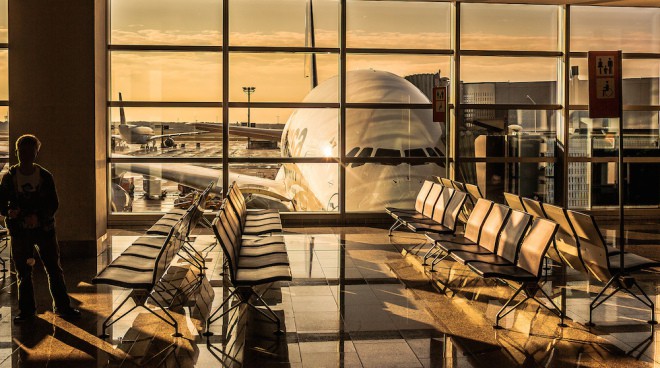
Angelo DeSantis (CC), Flickr
Happy holidays, constant readers. If you’re like many people, you may be preparing to take a trip, maybe for a break from winter, maybe just to see family. As you’re getting ready, making sure to decant the toiletries and pack the presents unwrapped, here’s one thing not to forget: your vaccinations.
Really, this is important. Last January, according to an account recently published by the Centers for Disease Control and Prevention, four unvaccinated people were infected with measles by a never-found fifth person during a single 4-hour window at an airport gate somewhere in the US.
The story was related last week in the CDC’s Morbidity and Mortality Weekly Report (the best-read magazine you’ve never heard of). None of the victims knew each other or were traveling together; as occurs every day in hundreds of airports, they just briefly happened to be in the same place at the same time.
All four victims — men, as it happens — were diagnosed with measles between Jan. 30 and Feb. 5 last winter. All four had traveled on Jan. 17 to or from the same unnamed airport, and three of the four were on separate flights. Here’s the CDC’s description:
Patient 1, an unvaccinated man aged 21 years with rash onset February 1, traveled on two domestic flights on January 17 and 18 that connected at the international airport. Patient 2, an unvaccinated man aged 49 years with rash onset February 1, traveled from the airport on January 17. Patient 3, an unvaccinated man aged 19 years with rash onset January 30, traveled domestically with at least a 4-hour layover at the airport on January 17. Patient 4, an unvaccinated man aged 63 years with rash onset February 5, traveled on a flight to the airport on January 17.
Patients 1 and 2 traveled on the same flight from the airport and were seated one row apart; both spent time at the departure gate before the flight. Patient 3, whose flight departed after the flight of patients 1 and 2, also reported spending time at this gate area during the time that patients 1 and 2 were present. Patient 4 passed through the same domestic gate around the time the other three patients were waiting to depart.
Because they all came down with measles at the same time, and therefore must have been infected at the same time, none of the four could have infected the other three; instead, the assumption goes, there was an unknown fifth person either in the gate area, or walking through it (as one of the victims did) who was in the infectious stage of the disease.
If you think of the size of an airport gate area — a couple of hundred square feet, maybe — it is very possible for infection to have occurred that way: Measles is one of the most contagious diseases around. The virus is airborne, so it can travel the length of a room; survives on hard surfaces for several hours; and causes infection in up to 9 out of 10 unvaccinated people exposed to it. Which is not a good result: Measles is a very bad disease, causing pneumonia and encephalitis in children and miscarriage and premature birth in pregnant women. (Here’s the CDC’s reference on measles, a chapter in what’s called The Pink Book even though it now lives on the web.)
Measles is a reportable disease in the US, meaning that when doctors diagnose it, they must tell health authorities; so when the travelers from this airport landed in other states, the CDC was alerted and tracked the cases back. The only thing they had in common was a four-hour window at that gate. An important point: Though the airport was one with international connections, the infection occurred at a gate on the domestic side — emphasizing, according to the CDC, “that measles is highly contagious and that measles continues to pose a risk for infection among unvaccinated persons in the United States.”
Measles was once an almost-beaten disease in the US; 10 years ago, there were only about 50 cases here. This year, there have been 610, due partly to importation from other countries, but also to people in the US being unvaccinated and thus providing the disease a toehold. In many countries, measles is much less controlled than it is in the US; this year, for instance, there have been 55,000 cases in the Philippines, enough for the CDC to declare a “travel alert” for people going there. But as this one cluster indicates, you don’t have to go somewhere that is experiencing a raging measles epidemic in order to be in danger from the disease. All you have to do is go to the airport.
Cite: Vega JS, Escobedo M, Schulte CR et al. “Notes from the Field: Measles Transmission at a Domestic Terminal Gate in an International Airport — United States, January 2014.” MMWR Dec. 19, 2014 / 63(50);1211-1211